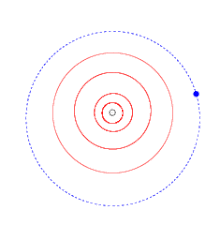15760 Albion
 Orbit of the four outer planets (red) compared to (15760) Albion (blue) | |
| Discovery [1][2] | |
|---|---|
| Discovered by |
D. C. Jewitt J. X. Luu |
| Discovery site | Mauna Kea Obs. |
| Discovery date | 30 August 1992 |
| Designations | |
| MPC designation | (15760) Albion |
Named after | Albion [3] (mythology by William Blake) |
| 1992 QB1 | |
|
TNO [1] · cubewano [4][5] (cold)[6] distant [3] | |
| Orbital characteristics [1] | |
| Epoch 4 September 2017 (JD 2458000.5) | |
| Uncertainty parameter 3 | |
| Observation arc | 21.10 yr (7,707 days) |
| Aphelion | 46.566 AU |
| Perihelion | 40.843 AU |
| 43.704 AU | |
| Eccentricity | 0.0655 |
| 288.93 yr (105,531 days) | |
| 31.005° | |
| 0° 0m 12.24s / day | |
| Inclination | 2.1877° |
| 359.44° | |
| 0.6029° | |
| Physical characteristics | |
Mean diameter |
108 km[6] 167 km[4] |
| 0.2 (assumed)[6] | |
| ~23.4[7] | |
| 7.1[1] | |
|
| |
15760 Albion, provisional designation 1992 QB1, was the first trans-Neptunian object to be discovered after Pluto and Charon. It was discovered in 1992 by David C. Jewitt and Jane X. Luu at the Mauna Kea Observatory, Hawaii. It is a "cold" classical Kuiper belt object and gave rise to the name cubewano for this kind of object, after the QB1 portion of its designation.[8] Decoding its provisional designation, "QB1" reveals that it was the 27th object found in the second half of August of that year. As of January 2018, over 2,400 further objects have been found beyond Neptune, a good number of which are classical Kuiper belt objects. It was named after Albion from William Blake's mythology.[9]
Naming
This minor planet was named after Albion from the complex mythology of English poet and painter William Blake (1757–1827). Albion is the island-dwelling primeval man whose division resulted into The Four Zoas: Urizen, Tharmas, Luvah/Orc and Urthona/Los. The name Albion itself derives from the ancient and mythological name of Britain.[3] The official naming citation was published by the Minor Planet Center on 31 January 2018 (M.P.C. 108697).[10]
The discoverers suggested the name "Smiley" for (15760) 1992 QB1,[11] but the name was already used for an asteroid 1613 Smiley, named after the American astronomer Charles Hugh Smiley. It has received the number 15760[5] and remained unnamed until January 2018 (it was normally referred to simply as "QB1", even though this was technically ambiguous without the year of discovery).
Notes
^ Minor planet and asteroid provisional designations follow a format, in which the year it was discovered comes first, followed by the half-month it was discovered alphabetically (e.g. A=January 1–15, B=January 16–31 and so on, but skipping the letters I and Z) and then the order of its discovery alphabetically followed by a number (e.g. 1992 QA, 1992 QB, 1992 QC ... 1992 QY, 1992 QZ, 1992 QA1, 1992 QB1 and so on.) According to this, Q=August 16–31 and B1=25+2=27.
References
- 1 2 3 4 "JPL Small-Body Database Browser: 15760 Albion (1992 QB1)" (2013-10-06 last obs.). Jet Propulsion Laboratory. Retrieved 6 February 2018.
- ↑ "IAUC 5611: 1992 QB1". IAU Minor Planet Center. 14 September 1992. Retrieved 2011-07-05.
- 1 2 3 "15760 Albion (1992 QB1)". Minor Planet Center. Retrieved 6 February 2018.
- 1 2 William Robert Johnston (28 December 2015). "List of Known Trans-Neptunian Objects". Johnston's Archive. Retrieved 2015-01-03.
- 1 2 Marc W. Buie (30 November 1999). "Orbit Fit and Astrometric record for 15760". SwRI, Space Science Department. Retrieved 2008-09-28.
- 1 2 3 Mike Brown, 'How many dwarf planets are there in the outer solar system? Archived October 18, 2011, at the Wayback Machine. Accessed 2014-11-19
- ↑ "AstDys (15760) 1992QB1 Ephemerides". Department of Mathematics, University of Pisa, Italy. Retrieved 2010-03-03.
- ↑ Dr. David Jewitt. "Classical Kuiper Belt Objects". David Jewitt/UCLA. Archived from the original on July 5, 2013. Retrieved July 1, 2013.
- ↑ "(15760) Albion = 1992 QB1". IAU Minor Planet Center. Retrieved February 3, 2018.
- ↑ "MPC/MPO/MPS Archive". Minor Planet Center. Retrieved 6 February 2018.
- ↑ What Lurks in the Outer Solar System? (Science@NASA, 13 September 2001)